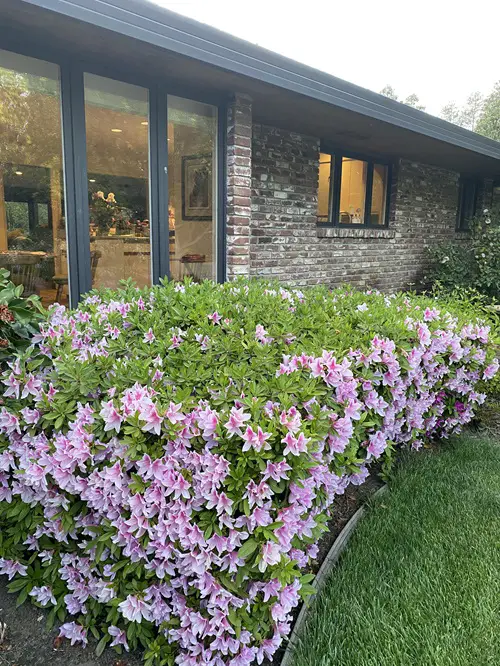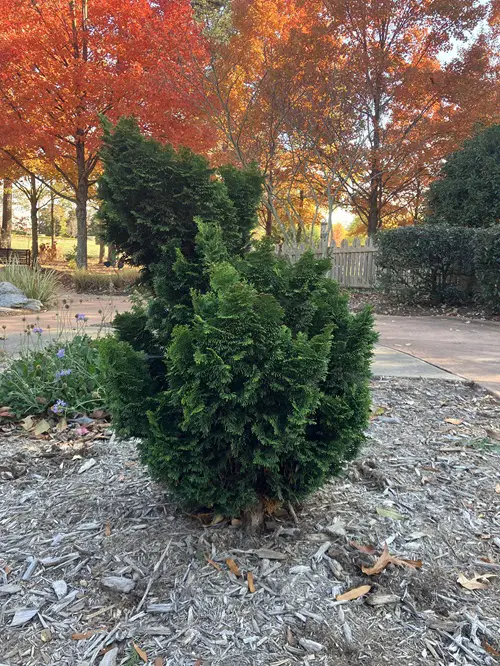Evergreen shrubs like Boxwood are long-lasting garden staples. But since they don’t grow well everywhere, we share the Best Alternatives!
Boxwood (Buxus) are slow-growing shrubs that lend year-round evergreen symmetry and structure to a space. Popular as hedges and topiaries, poor practices like over-shearing have made it unviable and vulnerable to disease. Here are the best alternatives to the quintessential boxwood, which is likely more manageable and natural to your setting!
Best Boxwood Alternatives
1. Mirror Bush
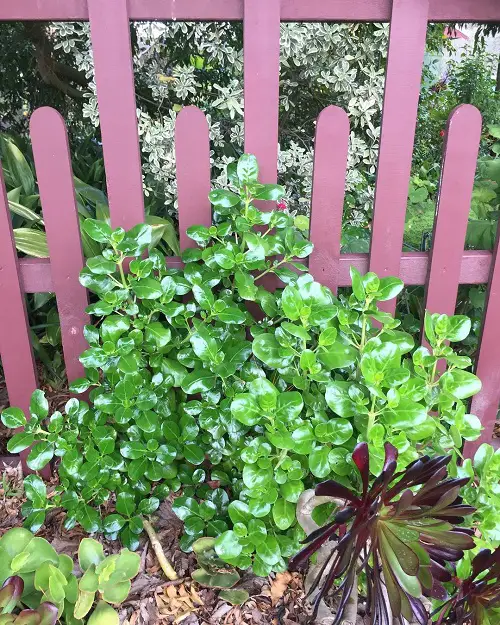
Botanical Name: Coprosma repens
USDA Zones: 8-11
This is an amazing alternative to boxwood with beautiful variegated patterns on leaves. The foliage of this shrub has green, gold, and orange hues that come out more vividly with the coolness of fall.
Mirror bush grows well in full sunlight, is drought-tolerant, and is an easy-to-maintain landscaping option.
2. Winter-Hazel

Botanical Name: Distylium
USDA Zones: 6-9
Distylium’s round and spreading growth habit is perfect for a lush garden setting. Its dense, layered foliage of small leaves gives it a solid look. Although this shrub is not popular for its blooms, its maroon hues in late winter are surely a welcome sight.
Depending on the variety, it can grow up to 10 feet tall if not pruned and look stunning in garden corners.
3. Inkberry Holly
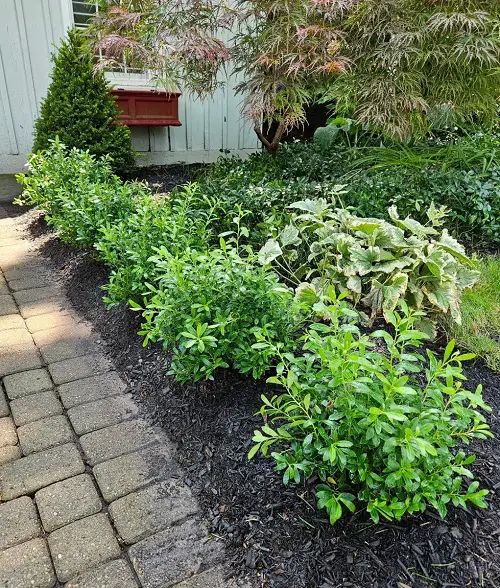
Botanical Name: Ilex glabra
USDA Zones: 4-11
With its upright growth habit, inkberry holly is perfect for winter greenery. You have to be a bit patient with this shrub, as it is a relatively slow grower, but its easy-to-care nature makes it a garden favorite.
Some inkberry cultivars like ‘Shamrock’ have beautiful blue-green foliage, while others are known for their green leaves and denser growth patterns. This one does well under the sun and some shade and loves neutral to slightly acidic soil.
4. Spreading Plum Yew
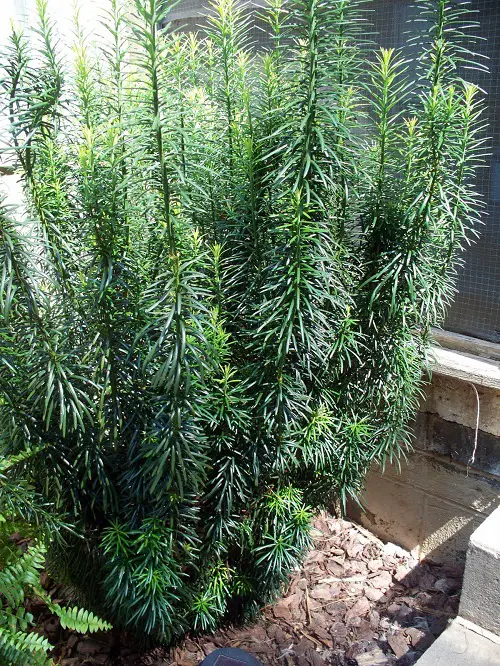
Botanical Name: Cephalotaxus harringtonia ‘Prostrata’
USDA Zones: 6-9
If you have trouble shaping and designing your shaded garden, Spreading Yew has the answers. Its ability to survive in full and partial shade makes it the ideal option for the dull and dim corners of your garden. Its needle-like strips of foliage and low-growing habit also stack up beautifully as a garden border or hedge.
5. Camellia Sasanqua

Botanical Name: Camellia sasanqua
USDA Zones: 7-9
This camellia variety is a top pick as a boxwood alternative for its stunning blooms, adaptability, and bushy growth habit. It thrives in full sun to partial shade and can traverse all sections of your garden.
Its evergreen glossy foliage stays lush throughout the year. Like most camellias, all it needs is moist and well-drained soil.
6. Fringe Flower

Botanical Name: Loropetalum chinense
USDA Zones: 7-9
Also known as the Chinese fringe flower, this plant has broad evergreen or semi-evergreen leaves and arching branches. Its growth habit makes it a perfect candidate for creating a green screen around your garden. On average, this shrub can grow 6-8 feet tall and have an equal spread.
In spring, clusters of slightly scented white and red flowers emerge.
7. Dwarf False Cypress
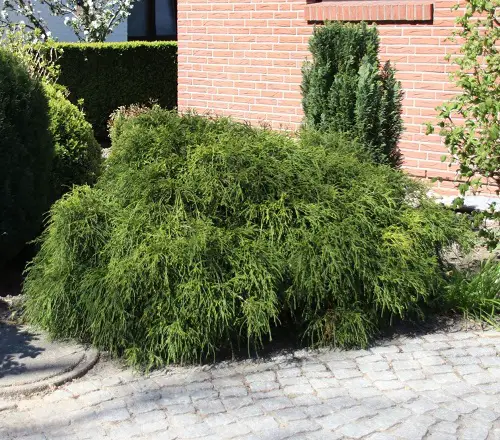
Botanical Name: Chamaecyparis pisifera ‘Filifera Nana’
USDA Zones: 4–9
This plant grows like a pyramid or a bushy mound, giving your landscape an air of festivity! In the wild, dwarf false cypress grows to great heights, but domesticated ones can reach up to a manageable five feet.
Go with this drought-tolerant variety if you are looking for a boxwood alternative for your rock garden and sometimes forget to water your plants.
8. Sweetbox
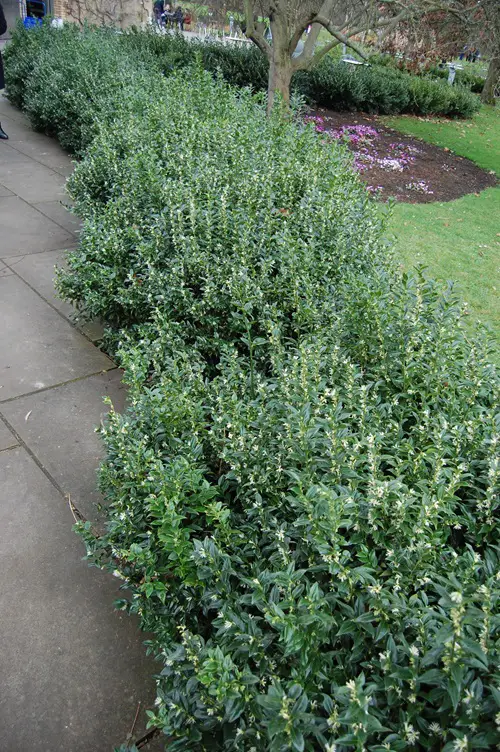
Botanical Name: Sarcococca confusa
USDA Zones: 5-9
Sweetbox is another boxwood alternative that loves growing in the shade. Scaling up to five feet tall, this plant will mesmerize you with vanilla-scented blossoms in spring. It is easy to care for and drought-tolerant once established.
There is only one downside to sweetbox; like boxwood, this one is also prone to boxwood blight.
9. Abelia

Botanical Name: Abelia x grandiflora
USDA Zones: 4-11
Gardeners who want both aesthetics and pollinator visits can grow Abelia. This plant has the best combination of glossy foliage and pink and white blooms that grow in beautiful clusters.
This boxwood alternative is also deer-resistant, deters pests, and drought and heat-tolerant.
10. Arborvitae
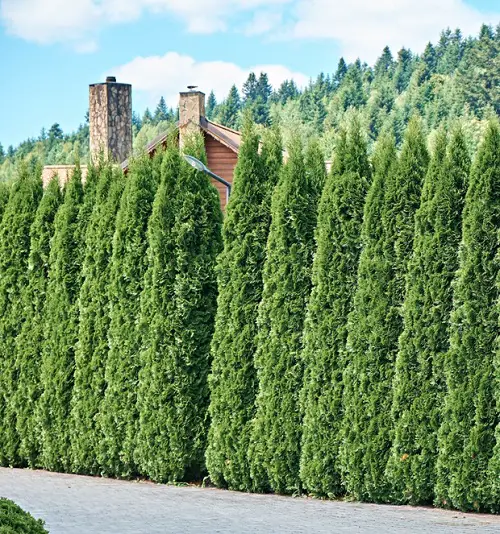
Botanical Name: Thuja occidentalis
USDA Zones: 2-10
Arborvitae love cool climates and come in many varieties suiting different conditions and climes. Tall and narrow, club a bunch of them together and you’ll have yourself a perfect living privacy screen!
This plant needs moist, well-draining soil and a spot that receives full sun to part shade. Remember to check out these varieties.
11. Azaleas
Botanical Name: Rhododendron spp.
USDA Zones: 6-9
This is the apt candidate if you are a boxwood fan and want a similar plant but with a more showy appearance. Azaleas’ flowers grow in big clusters of pink, red, yellow, orange, purple, and white hues. While most of these boxwood alternatives are grown for foliage, this one is more popular for flowers.
You can create beautiful hedges and topiaries from these shrubs with your perfect pruning skills.
12. Chinese Holly

Botanical Name: Ilex cornuta
USDA Zones: 6-9
Chinese holly has sharp-tipped leaves, distinguishing it quite a bit from the other boxwood alternatives on this list. Pair it with plants that are as drought-tolerant as this one is, and you can be as forgetful as you want about watering!
It grows well in average soil in full to partial shade. Varieties like ‘Burfordii’ grow up to 15 feet tall—perfect for privacy screens.
13. Japanese Holly
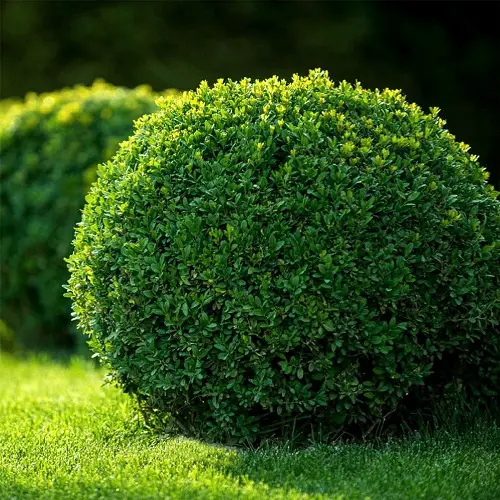
Botanical Name: Ilex crenata
USDA Zones: 5-9
With a much deeper green than boxwood, Japanese holly is an excellent landscape shrub with its dense and robust growth habit. It prefers to grow in slightly acidic soil but can tolerate other types as well.
14. Northern Bayberry
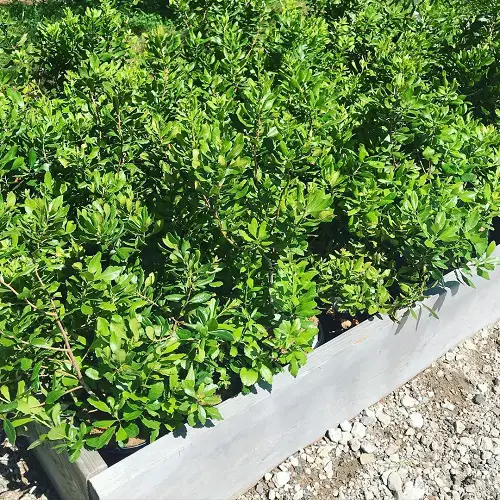
Botanical Name: Myrica pensylvanica
USDA Zones: 2-8
Northern bayberry is a densely branched shrub perfect for garden hedges. It spreads by rhizomes and is effective in controlling erosions on slopes. This drought-tolerant shrub also produces blue fruits from late summer through winter, luring hummingbirds to your garden.
15. Juke Box

Botanical Name: Pyracomeles ‘Juke Box’
USDA Zones: 7-9
Juke Box has glossy evergreen foliage and a mounded shape, which makes it perfect for small gardens. Although this is a relatively newer hybrid, it is quickly becoming popular as an alternative to boxwood.
You can prune it into beautiful shapes and topiaries or leave it wild and free. It thrives in full to part sun and isn’t fussy about watering.
16. Southern Wax Myrtle
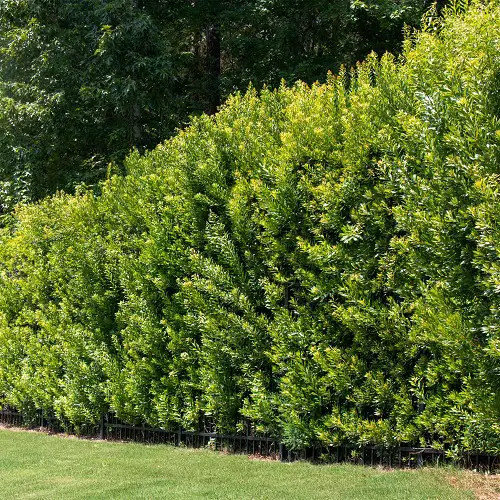
Botanical Name: Myrica cerifera
USDA Zones: 7-10
Closely related to northern bayberry, this one has olive-green leaves and attractive fruits that are a food source for many animals. When fresh growth sprouts, the plant shimmers a golden yellow, adding contrast and life to the garden.
Grow it in full sun to part shade and provide moist soil for best results.
17. Yaupon Holly
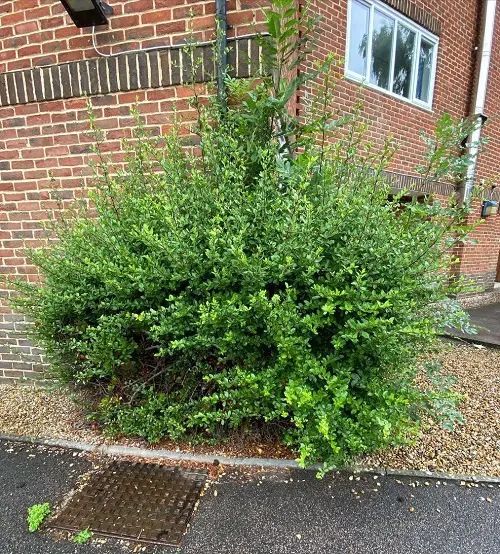
Botanical Name: Ilex vomitoria
USDA Zones: 7-9
The resilient Yaupon Holly is the best alternative if you live in hotter areas and cannot grow boxwood. It tolerates heat and can grow in dry, arid soil and climes, vigorously producing dark green leaves even with heavy pruning.
Avoid growing it in the shade, which may affect its fast-growing nature and wholesome looks.
18. Dwarf Hinoki Cypress
Botanical Name: Chamaecyparis obtusa ‘Nana’
USDA Zones: 4-8
This one needs a bit of patience. Dwarf Hinoki Cypress has fan-shaped leaves and horizontal branches, looking exquisite in the garden once mature. It prefers rich, well-draining soil.
19. Duranta
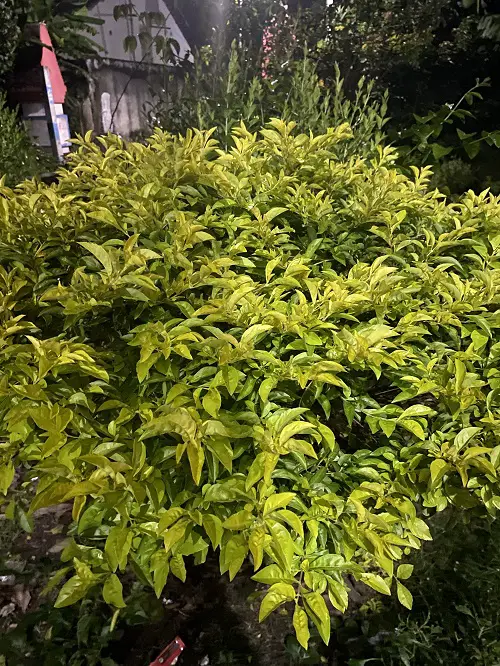
Botanical Name: Duranta erecta ‘Cuban gold’
USDA Zones: 9-11
This boxwood alternative is commonly known as the golden dewdrop. It is ideal for both indoor and outdoor cultivation. With beautiful clusters of blue-purple flowers, Duranta looks great as a landscaping plant in the garden, and indoors as an ornamental.
It tolerates rocky mediums but prefers rich, loamy soil.
20. Wintercreeper
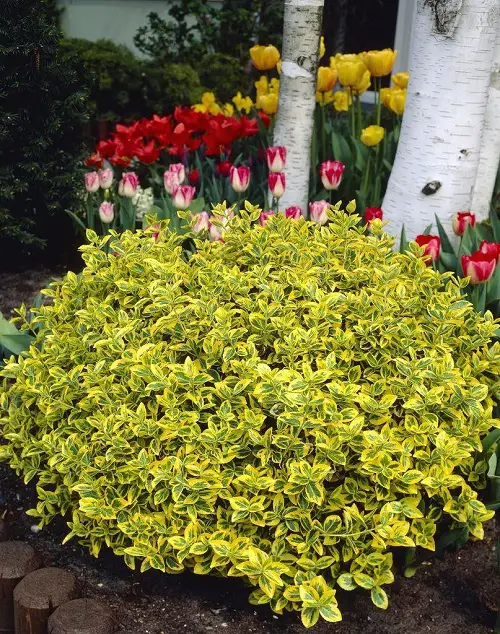
Botanical Name: Euonymus fortunei
USDA Zones: 4-9
This is the most unique boxwood alternative because of how dynamically it grows. Wintercreeper is perfect for landscaping, climbing, hanging, and experimenting with! It loves to bask in the sunshine for hours and show off its vivid green and golden color.
The only issue is that it is toxic to humans and pets.


